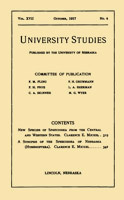University Studies of the University of Nebraska
Date of this Version
4-1914
Abstract
While studying the fossil woods of Nebraska, under the direction of Dr. E. H. Barbour, it was my good fortune to find an interesting specimen. This specimen is in the collection of fossil woods in the Nebraska State Museum, and was collected by Dr. Barbour from the Pliocene, or Snake Creek beds, about 20 miles south of Agate, Nebraska, during the summer of 1911.
The specimen itself is about six inches long by four inches wide and two inches thick. It has the appearance of typical agatized wood, but has numerous limonite streaks running through it. Upon sectioning the specimen, there was no woody structure to be seen, except very isolated cells of resistant tissue, such as the separate cells of tracheae. It showed all the signs of complete decomposition save in exceptional places. From a series of sections, it seems that the specimen is an Angiosperm of the diffuse porous type, but no further classification is possible.


Comments
Published in UNIVERSITY STUDIES, vol. XIV, no. 2 (April 1914). Published by the University of Nebraska.